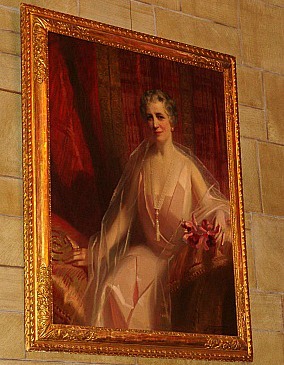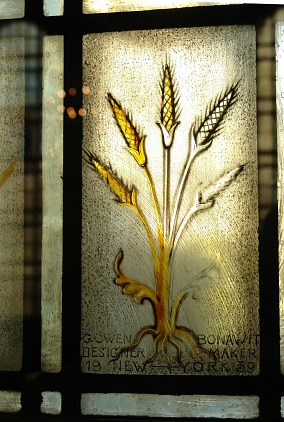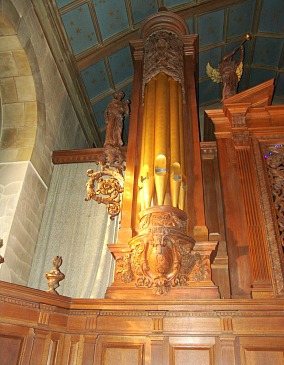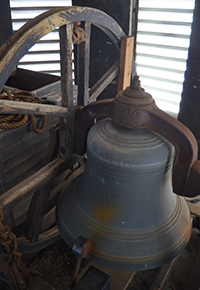Harkness Chapel, a gift to Connecticut College from Mary Stillman Harkness (1874-1950), was consecrated January 14, 1940. The non-denominational chapel seats 400 and is used by the College for religious services, musical recitals and special events. In the lower level are offices, meeting rooms and a library.
The Harkness family
 Mary Stillman Harkness was the daughter of a prominent New York lawyer and granddaughter of Thomas Greenman, a prosperous shipbuilder in Mystic, Conn. Her husband, Edward S. "Ned" Harkness (1874-1940), was heir to part of the Standard Oil Co. fortune.
Mary Stillman Harkness was the daughter of a prominent New York lawyer and granddaughter of Thomas Greenman, a prosperous shipbuilder in Mystic, Conn. Her husband, Edward S. "Ned" Harkness (1874-1940), was heir to part of the Standard Oil Co. fortune.
The couple shared an interest in philanthropy and during their lifetimes gave an estimated $120 million to various causes. Their primary interests were education and health care. They believed they had a responsibility to use their wealth wisely, and often financed projects that furthered their progressive ideals.
Mrs. Harkness maintained her southeastern Connecticut ties throughout her life. The couple, who had no children, kept a summer home named Eolia (meaning "formed by the winds") at the shore in Waterford. Their estate is now a Connecticut state park. The Harknesses contributed to many local causes over the years, including the founding of Connecticut College in 1911. Mrs. Harkness developed a friendship with Katharine Blunt, president from 1929-43 and 1945-46. In addition to the chapel, Mrs. Harkness gave the College a residence hall - Mary Harkness House, completed in 1934 - and also made gifts for the infirmary and library.
Mrs. Harkness took a keen interest in campus life. She visited "her dorm" frequently, always driven to the College by her chauffeur. She would receive guests and stay until well after dinner. Concerned that the campus lacked a center for religious study and activity, Mrs. Harkness decided in 1938 to give $380,000 for a chapel and the endowment of its upkeep.
Painting of Mary S. Harkness
The portrait of Mary Harkness that hangs in the gallery at the rear of the chapel was painted by British artist Frank O. Salisbury. It hung for many years over the mantel in the dining room at Mary Harkness House, a nearby residence hall that Mrs. Harkness gave to Connecticut College in 1934.
Salisbury (1874-1962) also painted a companion portrait of Mrs. Harkness' husband, Edward S. Harkness. Both are believed to have been commissioned in the early 1930s. The portrait of Mary Harkness is a copy of a painting at the Harkness mansion in Manhattan.
The architect
James Gamble Rogers (1867-1947) is best known for the classic "collegiate Gothic" buildings he designed for such universities as Yale, Northwestern and Columbia during the 1920s and '30s.
Many of Rogers' commissions were financed by philanthropist Edward S. Harkness, a close friend. The two met when Rogers was hired to design a Manhattan townhouse for Harkness and his wife, Mary Stillman, soon after their marriage in 1904. The Italian Renaissance mansion at 1 East 75th St. is now the headquarters of the Commonwealth Fund, a philanthropic entity created by the Harkness family in 1918.
Born in Kentucky, Rogers was a Yale graduate — as was Harkness. Like the Harknesses, he had a summer home in southeastern Connecticut. Rogers developed a summer colony at Black Point in Niantic with several friends and designed many of the homes there.
Rogers was known for his ability to design institutional buildings that artfully blended historic sensibilities with modern practicality. During his lifetime, Rogers' work was at times dismissed as uninspired because of its traditional style. But today he is more widely appreciated for his attention to detail, sensitivity and masterful planning. Throughout Rogers' distinguished career he often collaborated with others who worked on the Connecticut College chapel, especially stained glass artist G. Owen Bonawit.
Construction of the Chapel
Architect James Gamble Rogers drew up initial plans for the chapel in December 1937. President Blunt announced Mrs. Harkness' gift at Commencement the following June.
Rogers wanted the chapel to blend well with the College's Gothic, Georgian and modern architecture. He also wanted the design to be in keeping with Connecticut's colonial heritage. His solution was a granite façade with long, narrow windows and massive front doors flanked by two Ionic columns. The styles and details blend masterfully to create a dignified, simple building that Rogers described as "colonial Georgian."
The interior, with its wrought-iron chandeliers, stone floor, sturdy oak pews and horsehair cushions, reveals subtle and at times playful detail. Stalks of wheat, each drawn individually, wave in the panes of window glass. Fanciful designs embellish the trusses that traverse the vaulted ceiling. A radiant sunburst dominates the elaborate oak organ case behind the altar; at the top are two angels, their gilded horns blaring. A single flower is etched in the back of each of the 42 choir seats.
Initial plans called for a nonsectarian building with a weathervane on the steeple, stained glass windows featuring heraldic shields, and an engraving of the College motto over the front doors. The final design was far more religious: The steeple was topped with a cross, the windows portrayed scenes from the life of Christ, a large cross was hung from the organ case and the stone above the doors described Mrs. Harkness' interest in the spiritual life of students. It's not clear how the changes came to be made. But Mrs. Harkness was intimately involved in the details of the chapel's construction and undoubtedly approved them. She chose the color of the seat cushions (plum), rejected Rogers' wooden steeple in favor of stone, and approved the glass for the windows.
The Chapel since 1940
Because of its excellent acoustics, Harkness Chapel has always been a popular venue for Connecticut College concerts and musical recitals. It has also been the setting for lectures by such speakers as Paul Tillich, Daniel Berrigan, Reinhold Niebuhr, William Sloane Coffin and Henry Sloane Coffin. Religious services were mandatory for students until the 1960s; seats were assigned and attendance was taken by a proctor who sat in the gallery.
Today, the building is still used for music programs as well as special events, meetings and a variety of services. The College has tried to make the chapel more nonsectarian by reaching out to non-Christian groups, removing much of the Christian symbolism in the building and making some of the design elements more secular. In 1990, for example, the cross on the organ case was removed and the cross on the steeple was replaced with a weathervane fabricated from Rogers' original design.
 The Bonawit stained glass windows
The Bonawit stained glass windows
The windows of Harkness Chapel were among the last made by G. Owen Bonawit (1891-1971). The son of a commercial illustrator in Brooklyn, Bonawit's uncle was noted stained glass artist Owen J. Bowen, an associate of Louis Tiffany, John LaFarge and Otto Heinigke. Bonawit went into business for himself in 1918 and by 1930 employed 15 craftsmen. But the Depression took a toll. When Bonawit won the Harkness commission in 1939, he apparently was working alone; his name appears on the windows as the sole designer and maker. In 1941 Bonawit closed his shop and moved to the Southwest. There he launched a successful career as a technical photographer.
Bonawit is best known for his secular work, especially in libraries designed by Rogers at Yale and Northwestern. The brown and gold glass that dominates the Harkness windows is one of Bonawit's hallmarks. According to Rogers' notes on the design of the chapel, it was Bonawit who suggested the basic scheme for the windows. They should feature, Rogers wrote, "quite simple and light glass with spots of colored pieces... similar to the windows in some of the colleges at Oxford."
Twelve of the Harkness windows depict events in the life of Jesus. They are in chronological order, starting at the front of the east wall (facing the campus) and moving clockwise:
Annunciation
"And the angel said to her, 'Do not be afraid, Mary, for you have found favor with God. And now, you will conceive in your womb and bear a son, and you will name him Jesus.' " Luke 1:30-31
Adoration
"When they saw that the star had stopped, they were overwhelmed with joy. On entering the house, they saw the child with Mary his mother; and they knelt down and paid him homage." Matthew 2:10-11
Baptism of Christ by St. John the Baptist
"And when Jesus had been baptized, just as he came up from the water, suddenly the heavens were opened to him and he saw the Spirit of God descending like a dove." Matthew 3:16
Christ Raises the Son of the Widow of Nain
"Then he came forward and touched the bier, and the bearers stood still. And he said, 'Young man, I say to you, arise.' The dead man sat up and began to speak." Luke 7:14-15
The Transfiguration
"And he was transfigured before them, and his face shone like the sun, and his clothes became dazzling white. Suddenly there appeared to them Moses and Elijah." Matthew 17:2-3
The Raising of Lazarus by Christ
"He cried with a loud voice, 'Lazarus, come out!' The dead man came out, his hands and feet bound with strips of cloth, and his face wrapped in a cloth. Jesus said to them, 'Unbind him, and let him go.' " John 11:43-44.
The return of the Prodigal Son
"The father said to his slaves, "...Let us eat and celebrate, for this my son was dead and is alive again; he was lost and is found!' " Luke 15:22-24
The Entry into Jerusalem
"The great crowd that had come to the festival heard that Jesus was coming to Jerusalem. So they took branches of palm trees and went out to meet him, shouting, 'Hosanna! Blessed is the one who comes in the name of the Lord!' " John12:12-13
The Crucifixion
"When Jesus saw his mother, and the disciple whom he loved standing beside her, he said to his mother, 'Woman, behold, your son.' Then he said to the disciple, 'Behold, your mother.' And from that hour the disciple took her into his own home." John 19:26-27
The Resurrection
"The Son of Man must be handed over to sinners, and be crucified, and on the third day rise again." Luke 24:5.
The Women at the Sepulchre
"The angel said to the women, 'Do not be afraid; I know that you are looking for Jesus who was crucified. He is not here; for he has been raised, as he said.' " Matthew 28:4-6.
The Ascension of Christ
"When he had said this, as they were watching, he was lifted up, and a cloud took him out of their sight." Acts 1:9
The four remaining windows depict Christian themes:
The Lamb of God (semicircular window)
"Worthy is the Lamb that was slaughtered to receive power and wealth and wisdom and might and honor and glory and blessing!" Revelation 5:12
The Pelican, Symbol of Atonement (semicircular window)
According to ancient legend, in time of famine the pelican feeds her young with her own blood - as Christ is said to have sacrificed his life to atone for the sins of humanity.
North Rose Window behind the Altar
Christ as king surrounded by adoring angels.
South Rose Window
The Tree of Jesse, showing Christ as a descendant of David and Jesse, with Abraham and Moses.
"A shoot shall come out from the stump of Jesse, and a branch shall grow out of his roots." Isaiah 11:1
Decorative painting
Decorations on the ceiling of Harkness Chapel depict celestial, geometric and mythological themes. Gold stars crown the midnight-blue sky over the gallery at the rear of the building as well as the choir stalls at the front. Lions, griffins and dragons prowl the ceiling beams above the nave. The trusses are decorated with symbols associated with the writers of the four Christian gospels: a man for Matthew, a lion for Mark, an ox for Luke and an eagle for John. Rogers said in his design notes that the decorations would help make the chapel "more cheerful."
The artwork was done by George Davidson (1889-1965), a native of Russia who was raised in Hartford, Conn. Davidson taught painting at Cooper Union Art School in New York and was also a noted portrait artist.
His commissions included the Buffalo (N.Y.) Savings Bank, state office buildings in Texas and Tennessee, and the Mount Royal Hotel in Montreal. He worked with Rogers on buildings at Columbia and Yale. Connecticut College records show Davidson was paid $3,590 - more than twice the average annual income for a high school graduate in 1940 - for his work at Harkness.

The organ
Austin designed the organ in consultation with J. Lawrence Erb, the Connecticut College organist and professor of music from 1923-42. "Afternoons he may be found happily immersed in the organ pit in the chapel luring the soul from the fine Austin," the College alumni magazine reported in spring 1942. It has 47 speaking stops controlling 3,000 pipes.
The organ was one of two that were intended to showcase Austin's new, more refined tonal style after a corporate reorganization in 1937. Erb's successor, Arthur W. Quimby, is believed to be the first person to perform the entire works of Bach on an Austin organ. The concerts spanned three years.

The chapel bell
The chapel bell sounds hourly. It is inscribed, "Great is truth and mighty above all things," from 1 Esdras 4:41, an apocryphal book included in some versions of the Old Testament.
The verse personifies truth as a woman of great strength. Perhaps not coincidentally, at the time the chapel was built Connecticut College only admitted women. The first men were enrolled in 1969.
It tolls annually 100+ times on Founders Day.